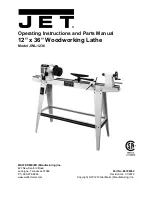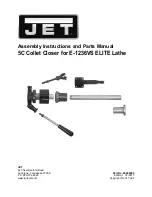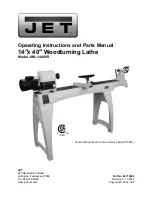
-1-
Table of Contents
Introduction 2
Foreword 2
Contact Info
2
Functional Overview
2
Safety Instructions
3
Lathe Safety
4
Section 1 : Controls & Components
5
Identi
fi
cation
5
Control Panel
6
Headstock Controls
6
Carriage Controls
7
Tailstock Controls
7
Foot Brake
7
Section 2 : Setup
8
Physical Environment
8
Electrical Installation
8
Lighting 8
Weight Load
8
Space Allocation
8
Lifting & Moving
8
Leveling 9
Test Run
10
Spindle Break-in
11
Section 3 : Operation
13
CSS System
13
Chuck 13
Tailstock 15
Centers 16
Steady Rest
17
Follow Rest
17
Compound Slide
17
4-Way Tool Post
18
Apron Stop
18
Manual Feed
19
Spindle Speed
19
Power Feed
20
Positioning Gearbox Levers
21
Understanding Thread & Feed Rate Chart 21
End Gear Setup
22
Threading Controls
22
Cutting Fluid System
25
Section 4 : Maintenance
26
Schedule 26
Cleaning 26
Lubrication 26
Cutting Fluid System
31
Machine Storage
32
Section 5 : Service
33
Backlash Adjustment
33
Leadscrew End Play Adjustment
33
Gib Adjustment
34
Half Nut Adjustment
34
Feedrod Clutch Adjustment
35
V-Belts 35
Brake & Switch
36
Leadscrew Shear Pin Replacement
37
Gap Removal & Installation
38
Section 6 : Parts
39
Headstock 39
Gearbox 45
Apron 49
Dail Indicator
51
4-Way Tool Post
54
Saddles 56
Bed & Shafts
59
End Gear - 14"
61
End Gear - 16"
64
Main Motor
- The chip tray in the middle
67
Main Motor
- Front moveable chip tray optional
69
Cabinet & Panel
- The chip tray in the middle
71
Cabinet & Panel
- Front moveable chip tray optional
73
Cabinet & Panel
- Oil delivered
75
Conventional Tailstock
77
5C Collet Closer Attachment
79
Taper Attachment
81
Bed Stop
83
Bed Stop
- MICROMETER
84
Steady Rest
85
Follow Rest
86
Chip Cover
87






























